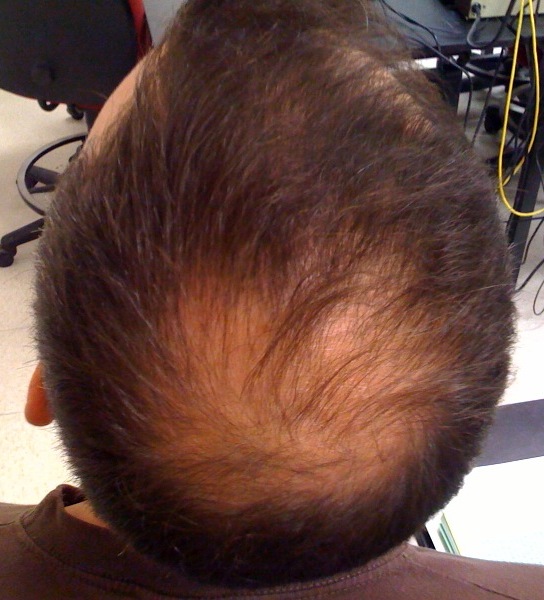Loose anagen syndrome

Editor-In-Chief: Prab R Tumpati, MD
Obesity, Sleep & Internal medicine
Founder, WikiMD Wellnesspedia &
W8MD medical weight loss NYC and sleep center NYC
| Loose anagen syndrome | |
|---|---|

| |
| Synonyms | Loose anagen hair syndrome |
| Pronounce | N/A |
| Specialty | N/A |
| Symptoms | Hair that is easily pulled out, alopecia |
| Complications | N/A |
| Onset | Childhood |
| Duration | Chronic |
| Types | N/A |
| Causes | Genetic factors |
| Risks | Blonde hair, female gender |
| Diagnosis | Trichogram, scalp biopsy |
| Differential diagnosis | Alopecia areata, trichotillomania |
| Prevention | N/A |
| Treatment | Gentle hair care, minoxidil |
| Medication | N/A |
| Prognosis | N/A |
| Frequency | Rare |
| Deaths | N/A |

Loose Anagen Syndrome is a condition that affects the hair growth cycle, resulting in hair that can be easily pulled out. It is most commonly seen in children, particularly girls, and is often diagnosed between the ages of 2 and 6. The condition is usually self-limiting and improves with age.
Symptoms[edit]
The primary symptom of Loose Anagen Syndrome is hair that can be easily pulled out, often without any pain. The hair may appear thin, sparse, or uneven in length. Other symptoms may include slow hair growth, hair that does not grow long, and hair that is easily damaged.
Causes[edit]
The exact cause of Loose Anagen Syndrome is not known. It is believed to be due to a defect in the hair shaft, which prevents the hair from anchoring properly to the scalp. This condition is often seen in individuals with a family history of the condition, suggesting a genetic component.
Diagnosis[edit]
Diagnosis of Loose Anagen Syndrome is typically made through a hair pull test. This involves gently pulling on a small amount of hair. If more than 10% of the hair is easily removed, this may indicate Loose Anagen Syndrome. A microscopic examination of the hair can also be used to confirm the diagnosis.
Treatment[edit]
There is no specific treatment for Loose Anagen Syndrome. The condition usually improves with age, and most individuals see an improvement by adolescence. In some cases, minoxidil may be used to help stimulate hair growth.
See Also[edit]
Ad. Transform your life with W8MD's Budget GLP-1 injections from $75


W8MD offers a medical weight loss program to lose weight in Philadelphia. Our physician-supervised medical weight loss provides:
- Weight loss injections in NYC (generic and brand names):
- Zepbound / Mounjaro, Wegovy / Ozempic, Saxenda
- Most insurances accepted or discounted self-pay rates. We will obtain insurance prior authorizations if needed.
- Generic GLP1 weight loss injections from $75 for the starting dose.
- Also offer prescription weight loss medications including Phentermine, Qsymia, Diethylpropion, Contrave etc.
NYC weight loss doctor appointmentsNYC weight loss doctor appointments
Start your NYC weight loss journey today at our NYC medical weight loss and Philadelphia medical weight loss clinics.
- Call 718-946-5500 to lose weight in NYC or for medical weight loss in Philadelphia 215-676-2334.
- Tags:NYC medical weight loss, Philadelphia lose weight Zepbound NYC, Budget GLP1 weight loss injections, Wegovy Philadelphia, Wegovy NYC, Philadelphia medical weight loss, Brookly weight loss and Wegovy NYC
|
WikiMD's Wellness Encyclopedia |
| Let Food Be Thy Medicine Medicine Thy Food - Hippocrates |
Medical Disclaimer: WikiMD is not a substitute for professional medical advice. The information on WikiMD is provided as an information resource only, may be incorrect, outdated or misleading, and is not to be used or relied on for any diagnostic or treatment purposes. Please consult your health care provider before making any healthcare decisions or for guidance about a specific medical condition. WikiMD expressly disclaims responsibility, and shall have no liability, for any damages, loss, injury, or liability whatsoever suffered as a result of your reliance on the information contained in this site. By visiting this site you agree to the foregoing terms and conditions, which may from time to time be changed or supplemented by WikiMD. If you do not agree to the foregoing terms and conditions, you should not enter or use this site. See full disclaimer.
Credits:Most images are courtesy of Wikimedia commons, and templates, categories Wikipedia, licensed under CC BY SA or similar.
Translate this page: - East Asian
中文,
日本,
한국어,
South Asian
हिन्दी,
தமிழ்,
తెలుగు,
Urdu,
ಕನ್ನಡ,
Southeast Asian
Indonesian,
Vietnamese,
Thai,
မြန်မာဘာသာ,
বাংলা
European
español,
Deutsch,
français,
Greek,
português do Brasil,
polski,
română,
русский,
Nederlands,
norsk,
svenska,
suomi,
Italian
Middle Eastern & African
عربى,
Turkish,
Persian,
Hebrew,
Afrikaans,
isiZulu,
Kiswahili,
Other
Bulgarian,
Hungarian,
Czech,
Swedish,
മലയാളം,
मराठी,
ਪੰਜਾਬੀ,
ગુજરાતી,
Portuguese,
Ukrainian


